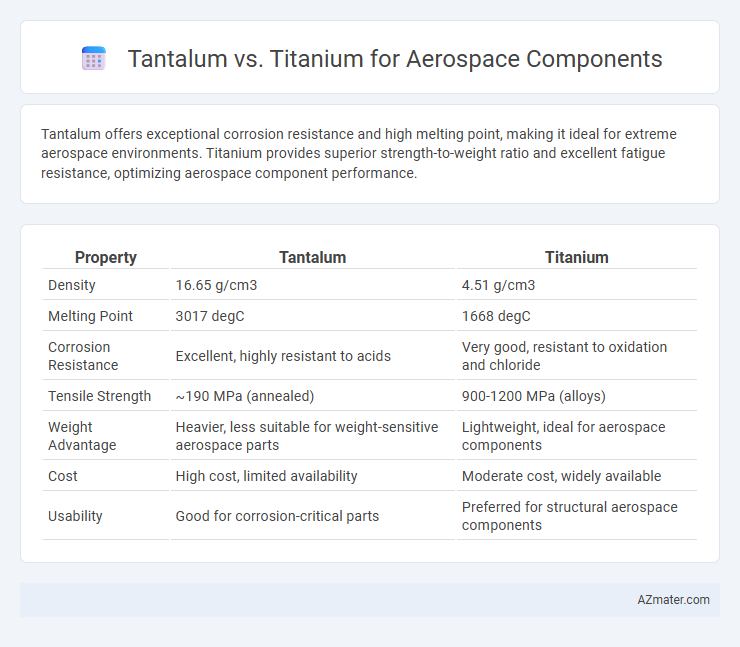Tantalum offers exceptional corrosion resistance and high melting point, making it ideal for extreme aerospace environments. Titanium provides superior strength-to-weight ratio and excellent fatigue resistance, optimizing aerospace component performance.
Table of Comparison
| Property | Tantalum | Titanium |
|---|---|---|
| Density | 16.65 g/cm3 | 4.51 g/cm3 |
| Melting Point | 3017 degC | 1668 degC |
| Corrosion Resistance | Excellent, highly resistant to acids | Very good, resistant to oxidation and chloride |
| Tensile Strength | ~190 MPa (annealed) | 900-1200 MPa (alloys) |
| Weight Advantage | Heavier, less suitable for weight-sensitive aerospace parts | Lightweight, ideal for aerospace components |
| Cost | High cost, limited availability | Moderate cost, widely available |
| Usability | Good for corrosion-critical parts | Preferred for structural aerospace components |
Introduction to Tantalum and Titanium in Aerospace
Tantalum and titanium are critical materials in aerospace engineering due to their unique properties. Tantalum offers exceptional corrosion resistance, high melting point, and excellent biocompatibility, making it ideal for components exposed to extreme environments and aggressive chemicals. Titanium provides a superior strength-to-weight ratio, corrosion resistance, and thermal stability, widely used in airframe structures, engine components, and fasteners where reducing weight without compromising strength is essential.
Chemical and Physical Properties Comparison
Tantalum exhibits exceptional corrosion resistance due to its stable oxide layer, making it highly suitable for aerospace components exposed to extreme environments, while titanium offers an excellent strength-to-weight ratio with a density of around 4.5 g/cm3 compared to tantalum's 16.6 g/cm3. Titanium's high tensile strength (up to 1,400 MPa in alloys) and low thermal expansion coefficient complement its resistance to fatigue and fracture, whereas tantalum's superior melting point (3,017degC) and ductility contribute to performance under high-temperature conditions. Both metals demonstrate biocompatibility and non-magnetic properties, but titanium's lighter weight and ease of fabrication generally favor its use in aerospace structural applications, whereas tantalum is preferred for critical corrosion-resistant components.
Strength-to-Weight Ratio: Tantalum vs Titanium
Titanium exhibits a superior strength-to-weight ratio compared to tantalum, making it a preferred choice for aerospace components where weight reduction is critical. Tantalum, although possessing higher density and excellent corrosion resistance, offers lower strength relative to its weight, limiting its application in weight-sensitive aerospace structures. Engineers favor titanium alloys such as Ti-6Al-4V for their balance of strength, low density (around 4.5 g/cm3), and high fatigue resistance essential for aircraft and spacecraft performance.
Corrosion Resistance in Aerospace Environments
Tantalum exhibits exceptional corrosion resistance to aggressive aerospace environments, including resistance to acids and oxidation at high temperatures, outperforming titanium in highly corrosive applications. Titanium offers excellent corrosion resistance to atmospheric conditions and saltwater but can be susceptible to oxidation and embrittlement under extreme oxidative stress. Selecting tantalum over titanium for aerospace components provides enhanced durability and longevity in chemically aggressive, high-temperature environments, crucial for aerospace reliability.
Temperature Resistance and Thermal Stability
Tantalum exhibits exceptional temperature resistance, maintaining structural integrity up to 3,000degF (1,650degC), far surpassing titanium, which typically withstands temperatures up to 1,100degF (593degC). Its superior thermal stability and oxidation resistance make tantalum ideal for aerospace components exposed to extreme heat, such as jet engine parts and heat exchangers. Titanium, while lighter and strong, is more suitable for moderately high-temperature applications where weight savings are critical without extreme thermal demands.
Machinability and Fabrication Challenges
Tantalum offers superior corrosion resistance and high melting point but poses significant machinability challenges due to its hardness and tendency to gall, requiring specialized tooling and slow cutting speeds in aerospace component fabrication. Titanium, widely favored for aerospace applications, combines excellent strength-to-weight ratio with better machinability, though it still demands careful heat management and tooling to prevent work hardening and tool wear. Fabrication of both metals requires advanced machining techniques, but titanium's balanced machinability and performance make it the preferred choice for complex aerospace parts.
Cost Analysis and Availability
Tantalum exhibits higher raw material costs and limited global availability due to its rarity and concentrated mining regions, impacting aerospace component budget constraints significantly. Titanium offers a cost-effective alternative with abundant supply sources, benefiting from well-established extraction and refining processes that reduce overall production expenses. When assessing aerospace component manufacturing, titanium's affordability and widespread availability make it a preferred choice over tantalum despite tantalum's superior corrosion resistance and high-temperature performance.
Applications in Aerospace Components
Tantalum offers exceptional corrosion resistance and high melting point, making it ideal for aerospace components exposed to extreme temperatures and reactive environments, such as turbine blades and exhaust nozzles. Titanium provides a superior strength-to-weight ratio and excellent fatigue resistance, widely used in airframe structures, engine components, and landing gear to reduce overall aircraft weight while maintaining structural integrity. Both metals are critical in aerospace applications, with tantalum favored in high-temperature zones and titanium preferred for lightweight, load-bearing parts.
Sustainability and Recycling Considerations
Tantalum offers excellent corrosion resistance and high melting points, making it valuable for aerospace components, but its rarity and complex extraction process pose sustainability challenges. Titanium boasts a strong strength-to-weight ratio and is more abundant, allowing for more efficient recycling and lower environmental impact in aerospace applications. Recycling titanium alloys reduces energy consumption significantly compared to primary production, enhancing sustainability in aerospace manufacturing.
Conclusion: Choosing the Right Material for Aerospace
Tantalum offers excellent corrosion resistance and high-temperature stability, making it ideal for aerospace components exposed to extreme environments. Titanium provides superior strength-to-weight ratio and fatigue resistance, crucial for weight-sensitive airframe and engine parts. Selecting between tantalum and titanium depends on balancing thermal and mechanical requirements with manufacturing constraints for optimized aerospace performance.

Infographic: Tantalum vs Titanium for Aerospace component
 azmater.com
azmater.com